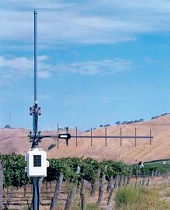Why does my equipment not transmit as far as it states it will on the specifications?
Why does my equipment not transmit as far as it states it will on the specifications? |
 | Wireless logging, weather stations and other various wireless environmental monitoring equipment has and will continue to grow in popularity. This is due to it making it simpler and more cost effective, some of the reasons include the fact no cables need to be run, or on occasion a single person can complete a task instead of multiple employees being required. In saying this wireless transmission does have some limitations and in this month’s newsletter we will cover what wireless range is, line of sight vs actual transmission range and the obstacles that can interfere with wireless range. • What is wireless range? • What is line of sight vs the actual transmission range you can expect? • What obstacles interfere most with wireless range? | |
What is the range of a wireless transmission?
The range of a wireless transmission relates to the distance that a transmission from a transmitter can be received by a receiver and is specific to the frequency and the environment between the transmitter and receiver.The simplest way to conceptualise wireless transmission is to think of the transmitter as a talker (this is all they do; they talk and do not listen). The receiver can be thought of as a listener and its job is to receive information from the transmitter. The transmitter sends a signal that the receiver receives and interprets and converts it to what you see on your display, logger or PC etc. The frequencies that the transmitters and receivers may vary depending on the product type and this can vary the line of sight transmission range that can be achieved. Line of sight will be explained in the next section. ‘Line of sight’ specifies the range of transmission that could be achieved with no obstructions or interference over the air gap. It basically refers to a perfect scenario and on most occasions is near impossible to achieve. The actual achievable transmission range varies significantly depending on the obstructions that lie between your transmitter and receiver and the frequency they operate on. If air is the only thing that lies between your transmitter and receiver then the ‘line of sight’ detailed in the specifications will likely be achievable, whereas obstructions with a higher density will diminish the wireless range to varying degrees. The frequency that your equipment operates on can also affect your transmission range. For instance a unit that operates on 2.4Ghz sees foliage as a significant obstruction whereas VHF that operates at 150Mhz doesn’t see foliage as much of an obstruction at all. Metal is the most prevalent obstruction and will almost completely block a transmission as there is not enough energy for it to pass through. For obstructions such as foliage, walls, concrete etc. this will affect the transmission range to varying degrees and in these instances the only way to confirm range is to test it. As a general rule a brick wall will half the specified transmission range and this can be applied to other obstructions as long as it is a conservative estimate and the material is of a similar construction to a brick wall. Another important consideration is the path that the transmission needs to take through the obstacle. For instance, a wall is thinner if the transmission passes through on a perpendicular plane to the wall. If the transmission has to pass through at an angle it will use more transmission energy and therefore reduce the range further than you may have anticipated. | ||
Contact our expert scientists now to get the right meter or data logger to suit your needs and discuss your project.
Phone: 1300 737 871
Email: [email protected]
